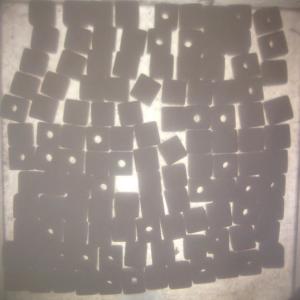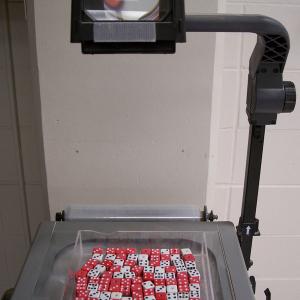College of Liberal Arts & Sciences
7D10.50 - Half Life - Dice
Place the clear box on the overhead projector and throw a layer of dice with holes into it. Take out all the dice that have light shining through them. Repeat the experiment. Each time you should be able to remove about 1/3 of the dice. If you count the total number of dice used, and the dice removed at each interval, you will be able to calculate the half-life.
- Bill Baird, "Radioactive Decay and Penetration Depth - Why Should There Be an e?", TPT, Vol. 52, #4, Apr. 2014, p. 234.
- Lynda Klein and David Kagan, "'Radio-Active' Learning: Visual Representation of Radioactive Decay Using Dice", TPT, Vol. 48, #1, Jan. 2010, p. 45.
- Art Hobson, "Hands-On Simulation", TPT, Vol. 42, #3, Mar. 2004, p. 132.
- Kenneth E. Jesse, "Computer Simulation of Radioactive Decay", TPT Vol. 41, #9, Dec. 2003, p. 542.
- Ludwik Kowalski, "Simulating Radioactive Decay with Dice", TPT, Vol. 19, #2, Feb. 1981, p. 113, also A Potpourri of Physics Teaching Ideas - Odds and Ends, p. 321.
- John L. Roeder, "Throwing Dice in the Classroom II", TPT, Vol. 18, #4, Apr. 1980, p. 302, also A Potpourri of Physics Teaching Ideas - Odds and Ends, p. 324.
- John L. Roeder, "Throwing Dice in the Classroom", TPT, Vol. 15, #7, Oct. 1977, p. 428, also A Potpourri of Physics Teaching Ideas - Odds and Ends, p. 323.
- R. Castillo, "An Analog of the Half-Life of a Radioactive Element", TPT, Vol. 6, #9, Dec. 1968, p. 467.
- Joseph Priest and James Poth, "Demonstrations for Teaching Nuclear Energy", AJP, Vol. 51, #2, Feb. 1983, p. 185.
- Borislaw Bilash II and David Maiullo, "The Meaning of (Half) Life", A Demo a Day: A Year of Physics Demonstrations, p. 363.
Disclaimer: These demonstrations are provided only for illustrative use by persons affiliated with The University of Iowa and only under the direction of a trained instructor or physicist. The University of Iowa is not responsible for demonstrations performed by those using their own equipment or who choose to use this reference material for their own purpose. The demonstrations included here are within the public domain and can be found in materials contained in libraries, bookstores, and through electronic sources. Performing all or any portion of any of these demonstrations, with or without revisions not depicted here entails inherent risks. These risks include, without limitation, bodily injury (and possibly death), including risks to health that may be temporary or permanent and that may exacerbate a pre-existing medical condition; and property loss or damage. Anyone performing any part of these demonstrations, even with revisions, knowingly and voluntarily assumes all risks associated with them.

